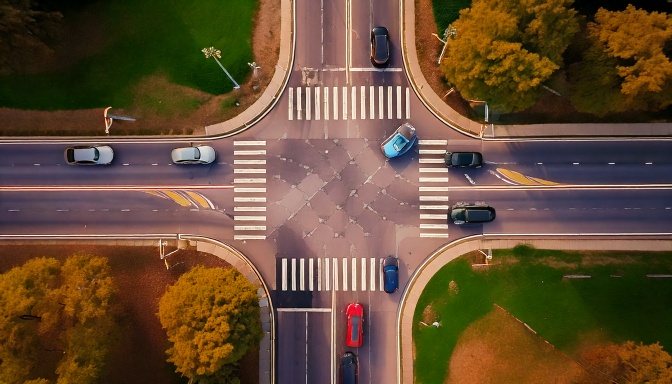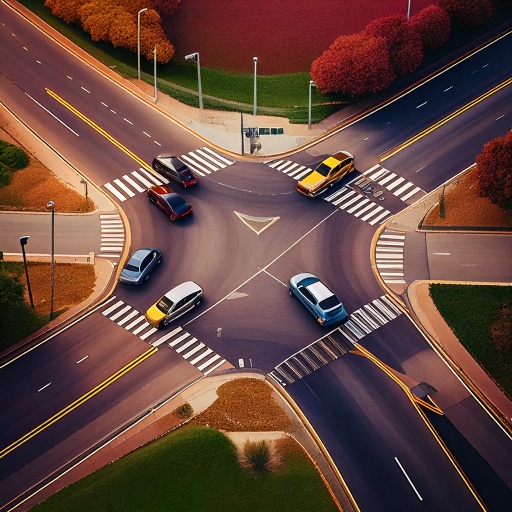Introduction
Four-way stops are designed to organize intersections where all approaching vehicles must stop, However, they’re also a frequent source of confusion, hesitation, and accidents, Many drivers are unsure who goes first, what to do when two cars arrive at the same time, or how to handle impatient drivers.
In this article, we’ll explain step-by-step how to handle four-way stops with confidence, You’ll also learn the most common mistakes drivers make and how to avoid them to keep traffic flowing and prevent collisions.
🗂️ Table of Contents
1- What Is a Four-Way Stop?
Four-way stops are not just about signage they’re about shared responsibility, These intersections function best when every driver understands their role, Unlike traffic lights that automate flow, four-way stops depend on driver judgment, attentiveness, and courtesy, They are typically installed in areas where visibility is limited or accident history is high, Local municipalities often prefer four-way stops for their low cost and effectiveness in managing moderate traffic volumes without signal installations.
A four-way stop is an intersection where all four directions have stop signs, Every driver must stop before proceeding, These stops are commonly found in residential areas and are meant to improve safety where traffic lights are unnecessary.
2- The Right-of-Way Rules Explained
If more than two cars arrive at different times, the rule of ‘first come, first go applies, However, if drivers arrive at the same time from opposite directions, the one going straight or turning right has priority over a driver turning left, This is a crucial rule often misunderstood, To avoid confusion, always signal your intent and proceed with caution.
The first rule: the first vehicle to arrive at the stop goes first, When multiple cars stop at the same moment, priority goes to the driver positioned on the right-hand side, Always make a complete stop and check all directions before proceeding.
3- What If Two Cars Arrive at the Same Time?
When two drivers approach the intersection simultaneously, the one to the right should proceed first, This rule applies even if one driver wants to go straight and the other wants to turn, If you’re unsure, make eye contact or use a hand wave to communicate.

4- Common Mistakes to Avoid
Some drivers hesitate too long at the stop, unsure when to go, which disrupts the flow of traffic and may cause other drivers to make incorrect assumptions, Others may wave multiple drivers on, which can result in all of them moving at once and increase the risk of a collision, Rolling stops, where drivers slow down but don’t fully stop, are another common issue and are illegal.
Some drivers roll through the stop, skip the stop entirely, or try to rush others. Another mistake is assuming that turning left has priority it does not, Failing to yield or hesitating too long can create confusion or accidents.
5- Tips for Handling Aggressive Drivers
It’s important to stay calm when encountering aggressive behavior, Maintain your position until it is legally and safely your turn, Avoid making eye contact with angry drivers and never respond with gestures or words, If the situation escalates, allow them to go a few seconds of delay is always better than confrontation.
If another driver tries to rush or wave you on incorrectly, stay calm, Let them go if it’s safer, Never argue or force your way through, Defensive driving is always the smarter choice in tense situations.
6- Special Situations: Pedestrians and Cyclists
Children or elderly pedestrians may need more time to cross, and cyclists might not always follow road rules perfectly, Be especially cautious in school zones or areas with heavy foot traffic, Remember that blind spots and distractions make it harder to see smaller road users like kids or people in wheelchairs. Slowing down and scanning all directions is key to avoiding tragic mistakes.
Pedestrians always have the right-of-way at crosswalks, Cyclists are considered vehicles and must also follow four-way stop rules, Yield to pedestrians first, then follow normal vehicle order.
7- Why Four-Way Stops Improve Safety
According to the Federal Highway Administration, four-way stops significantly reduce the frequency and severity of intersection crashes, especially T-bone collisions, They naturally slow down traffic, encourage eye contact among drivers, and create an environment of shared control, Studies show that replacing uncontrolled intersections with four-way stops lowers accident rates by more than 40%.
When used correctly, four-way stops reduce speeds increase driver attentiveness, and lower the risk of T-bone collisions, They are effective at intersections with moderate traffic volumes and poor visibility.
8- Final Driving Tips for Four-Way Stops
As a general rule, avoid distractions like phones or loud music when approaching intersections, Always look left, then right, then left again before proceeding, If you’re ever uncertain about who should go, yield to be safe, It’s better to lose a few seconds than cause an accident, Making these habits second nature ensures that every four-way stop you encounter becomes a moment of safety not risk.
Always approach slowly, stop fully, and scan for all road users, Don’t assume other drivers know the rules stay patient and predictable, Clear communication and steady decisions make these intersections safer for everyone.
Conclusion
Whether you’re a new driver or have years of experience, refreshing your understanding of four-way stops can improve your safety and confidence, When every driver takes responsibility for understanding and following the rules, roads become significantly safer, This small but important skill is a cornerstone of defensive driving and smart decision-making behind the wheel.
Mastering four-way stops is a basic but essential driving skill, By knowing who goes first and staying calm under pressure, you reduce the risk of confusion and collisions, Safe driving isn’t about winning it’s about making the correct decision at the right moment, Stay alert, respectful, and always follow the rules, Safe intersections start with informed drivers like you.
📌 Internal Link :
🌐 External Source :

